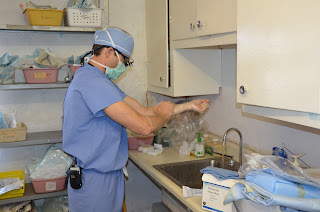Dr. Kraig Burgess and his Physician Assistant, Lisa Babel
traveled to the state of Sinaloa Mexico with LIGA International this April to
serve the communities of San Blas and El Fuerte on a medical mission’s trip. Dr. Burgess and Lisa are members of LIGA
International, “Flying Doctors of Mercy”, an organization providing medical and
surgical care to the under-served communities of rural Mexico since 1934. LIGA mission trips occur the first weekend of
each month from October through June. On
average 15-20 pilots donate their time and 4-6 passenger planes to transport
the Doctors and other health care providers with donated medical equipment to a
remote single runway airfield in El Fuerte.
The April trip provided Dr. Burgess a unique opportunity to
care for patients in his area of expertise, hand and upper extremity
surgery. The trip includes screening
surgical candidates and treating nonsurgical patients in a clinic setting. Once screened, the remaining time is spent
performing the surgical reconstructions. “I was immediately overwhelmed by the
need these people have for health care.
Many of the patient conditions have progressed to levels you would never
see here in the States where treatment would have been performed much earlier,”
said Dr. Burgess.
This particular trip over 340 patients were treated,
including surgeries performed in general, orthopedic hand, podiatry,
ophthalmology, OB/GYN, and cardiology. Dr.
Burgess and Lisa were able to see dozens of clinic patients and treat conditions
varying from pediatric congenital abnormalities, traumatic injuries, tumors,
tendinitis, arthritis and nerve injuries.
These surgeries included a 19 month old boy with a condition called
syndactyly, which presents with a webbed hand appearance. They also cared for a young girl who had been
badly burned and developed an infection, resulting in a partial amputation and
scar contractures to her hand. Another
gentleman had been injured by a machete, resulting in multiple tendon
lacerations and permanent nerve deficits.
Dr. Burgess recalls, “You have to get pretty creative and be willing to
adapt to the supply limitations in order to get things done. It’s pretty much self-service when it comes
to finding equipment, prepping the rooms and setting up for surgery. I could not have imagined accomplishing what
we did without my PA, Lisa’s help.”
As they recall the trip, what stood out more than anything was
how grateful the patients were and how accommodating the local people were to
the volunteers. “Patients traveled for hours, many by bus, to
sit and wait for hours just for hope, hope that something could be done to help
them. It was heartbreaking to not have
the equipment and time to help everyone,” Dr. Burgess said. Through the generosity of companies Dr.
Burgess works with; he has been able to obtain supplies which will allow him to
care for some of these patients on his next trip. Dr. Burgess and Lisa are planning their next
trip for this fall. To learn more about
this incredible organization, “Flying Doctors of Mercy” go to
www.ligainternational.org.
Lisa Babel, PA-C
Dr. Burgess
Dr. Burgess scrubbing up
Dr. Burgess & Lisa Babel, PA-C operating
“Patients traveled for hours, many by bus, to sit and wait for hours just for hope, hope that something could be done to help them...,” - - Dr. Burgess
TOCA
612-277-6211

















